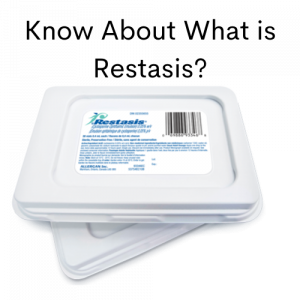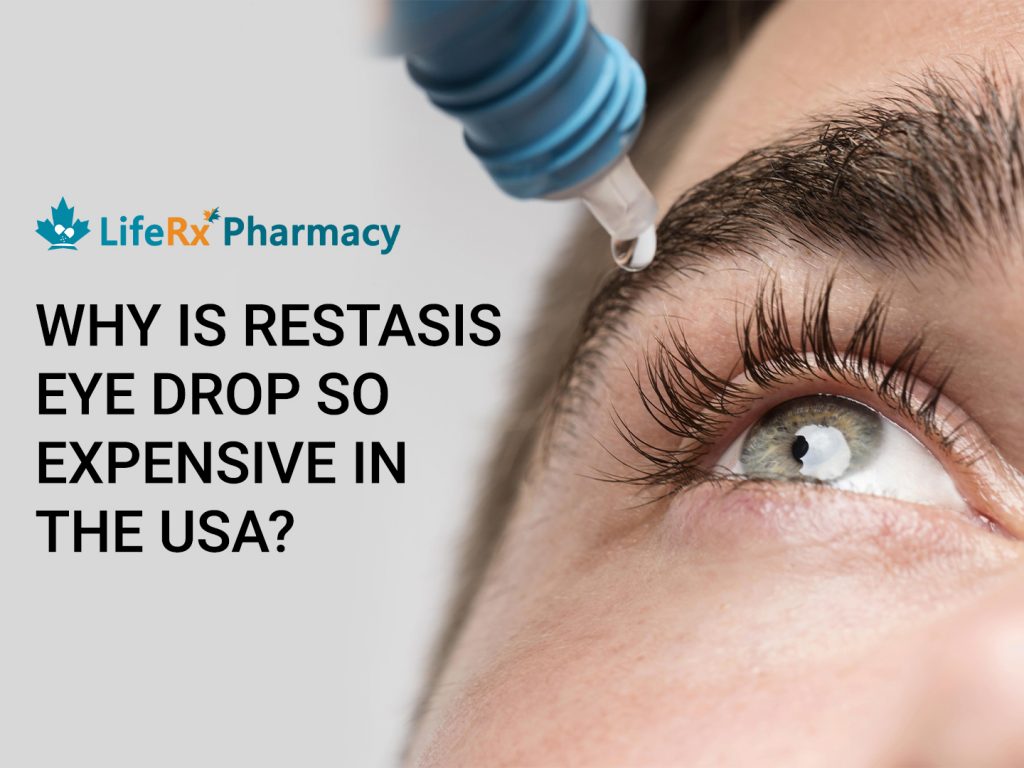For millions of Americans, even if they have health insurance and prescription medication coverage (but especially if they don’t), expensive and unaffordable prescription pharmaceuticals have become an awful fact of life. Restasis, made by Allergan, is one of a lengthy list of prescription medications whose prices have skyrocketed in recent years. Take, for example, the Restasis prescription eye medication. So, why are these medications so expensive?
This question, it turns out, has a solution. Even better, there are a couple of methods to save money on Restasis right now. Continue reading to find out more.
What is Restasis?
Cyclosporine is the active ingredient in Restasis. Cyclosporine is an immunosuppressive medication used to aid organ transplant recipients. It prevents the new organ from being rejected by the patient’s body. Cyclosporine is used to treat hyperactive immune responses in different ways. Psoriasis and rheumatoid arthritis, for example, are treated with cyclosporine.

Restasis is a medication that is used to treat persistent dry eyes. Inflammation is the underlying cause of chronic dry eye in certain persons. Inflamed tissues can affect the lacrimal glands, which are responsible for the production of tears. Patients’ eyes get dry and itchy when their lacrimal glands stop working. Chronic dry eye has a significant detrimental impact on patients’ quality of life. It also affects vision.
Restasis eye drops are used to treat this problem. Patients who use Restasis can administer cyclosporine directly to their eyes twice a day.
In the United States, how much does Restasis cost?
Restasis costs $586 per month on a wholesale basis in the United States. That works out to almost $7,032 each year. Prices, however, vary. Their insurance coverage and pharmacy discounts influence patients’ actual medicine costs. In addition, retail prices are usually greater than wholesale prices.
Restasis has an average retail price of $729.74. Medicare Part D patients may have to pay $42. They may, however, have to pay more than $640.
Few reasons why is Restasis so expensive in the USA:
A lack of oversight by the government:
Drug prices are set or regulated by the federal government in some countries. In the United States, however, this is not the case. Insurance companies are unable to bargain.
There is no single federal health insurance system in the United States. Instead, Americans purchase health insurance from a variety of private companies. Each insurance company has a meeting with pharmaceutical companies. Then it tries to negotiate the drug’s price to keep costs low for its recipients. Regrettably, insurance companies do not have much negotiating power. If a pharmaceutical business disagrees with the price of a drug, an insurance company can refuse to cover it.
However, if even one insurer agrees to cover the drug at a high cost, the other insurers lose their bargaining power. Americans will choose the insurer that covers the drug they desire if the other insurers walk away from the table.
Insurance businesses are easy to conquer since they are competitively divided. In essence, pharmaceutical businesses are free to determine their rates.
Struggles in the US Government’s Negotiations:
The federal government does not have the authority to determine medicine pricing unilaterally. It can, however, bargain on behalf of Medicare and Medicaid.
Unfortunately, these attempts have also been impeded. Medicare and Medicaid, in principle, serve as conduits between drug makers and patients. Because drug companies cannot afford to lose business, government negotiators have room to walk away from the table.
In practice, however, federal rules mandate that Medicaid and Medicare cover all FDA-approved pharmaceuticals. Negotiations between government departments are hampered as a result of this.
Even if they didn’t have this handicap, federal negotiators might not try very hard to lower drug prices. This is because pharmaceutical firms employ lobbyists. These lobbyists use convincing arguments–and campaign contributions–to persuade Congress members to oppose corporate profit restrictions.
Putting Profit First in Marketing:
Profit is a top priority for pharmaceutical businesses. Increasing demand is one approach to creating money. This is made possible by marketing. Regrettably, marketing is also costly. In fact, in 2020, pharmaceutical corporations will spend $6.58 billion on direct-to-consumer advertising. Spending money on marketing is a risk. The corporation intends to repay the costs by increasing medicine sales.
If each drug has a bigger profit margin, this is easier to accomplish. If a drug’s profit margin is high, the manufacturer doesn’t need to sell as many units to cover its costs. Marketing costs incentivize bigger profit margins in this way. As a result, drug prices rise.
Manipulation of Patent Law:
Every drug’s price is driven up by poor government negotiations and marketing costs. Restasis, in particular, exposes how firms manipulate patent rules to boost drug prices. Monopolies can be formed as a result of this manipulation. Monopolies eliminate competition to avoid competitive pricing.
Patent terms can last decades, making it nearly impossible for customers to find more affordable alternatives. If that wasn’t terrible enough, slight changes to a drug’s composition or delivery mechanism can be enough to qualify for a patent extension or new patent, further suffocating competition.
Patent dodging:
Allergan went to even greater lengths to protect Restasis, one of its most popular and profitable medications, from the competition. Allergen forged an unprecedented deal with the St. Regis Mohawk tribe in New York State to avoid what is already a loose patent regulation system in the United States, surprising and alarming even some of the most cynical pharmaceutical industry watchdogs and critics.
Tribes like the St. Regis Mohawk are exempt from and operate outside of federal jurisdictions in the United States, including patent rules, because they are sovereign nations. Allergan gave the tribe its Restasis patents, which are set to expire in 2024, and agreed to pay them licensing fees and a percentage of profits as a way to avoid patent challenges and generic dry eye medication competition.
Allergan’s attempts to shield themselves from US patent law ultimately failed, and they were defeated in several court rulings, which were settled by the US Supreme Court when it refused to hear the case, leaving the lower court rulings in place.
They may have lost that particular battle, but it demonstrates the lengths pharmaceutical firms would go to maintain market control and limit competition to protect their profits in the United States.
How to make your Restasis prescription cost less?

Dry eyes can be bothersome and even have an impact on a person’s productivity and quality of life, making contact lenses difficult to use and creating light sensitivity. As more people spend more time in front of screens than ever before, issues like the chronic dry eye will almost certainly become more widespread.
With over 40% of Americans unable to pay $400 in an emergency, and millions of people lately losing their employer-sponsored health insurance owing to unemployment due to the coronavirus epidemic, $600+ for a monthly supply of Restasis can be nearly hard to buy.
Many prescriptions have manufacturer coupons and assistance programs that can provide large discounts in some situations, but there are no guarantees and many patients do not qualify. Always check with the manufacturer and individual insurance plans for rebates and assistance programs that can help you save money on your medications.
Purchase Restasis for a Lower Price Today
“Why is Restasis so expensive?” is a question we can answer. But, even better, we can provide you with alternatives.
LifeRx Pharmacy is an online pharmacy. We’re prepared to bring you the meds you require at a reasonable cost. Using our safe and secure online ordering system, you can buy brand and generic Restasis online from us.
FAQs:
How does Restasis work?
Restasis works by reducing inflammation and increasing the production of natural tears in the eyes. Its active ingredient, cyclosporine, acts as an immunomodulator, suppressing the inflammatory response on the surface of the eye associated with conditions like dry eye syndrome. By decreasing inflammation and promoting tear production, Restasis helps alleviate the symptoms of dry eyes and improves overall eye comfort and health. Regular use of Restasis as prescribed by a healthcare professional can help manage chronic dry eye symptoms effectively.
How long does it take for Restasis to work?
Restasis typically takes several weeks to months to reach its full effectiveness. Some individuals may experience improvement in their dry eye symptoms within a few weeks of starting treatment, while others may require several months of consistent use before noticing significant relief. It’s important to follow the prescribed dosage and administration instructions provided by your healthcare provider and to be patient while waiting for Restasis to take effect. Consistent and continued use of Restasis is key to experiencing the maximum benefits for managing dry eye symptoms.
Can you use Restasis after cataract surgery?
Yes, Restasis can be used after cataract surgery to help manage dry eye symptoms that may occur as a result of the procedure. Cataract surgery can sometimes lead to temporary or persistent dry eyes due to changes in tear production or the eye’s surface. Restasis, with its ability to increase tear production and reduce inflammation, can be beneficial in alleviating these post-surgery dry eye symptoms. However, it’s essential to consult with your eye surgeon or healthcare provider before starting or continuing any medication regimen, including Restasis, following cataract surgery to ensure it’s appropriate for your circumstances.
Is Restasis preservative-free?
No, Restasis is not preservative-free. Each single-use vial of Restasis contains a preservative called benzalkonium chloride (BAK). BAK is a common preservative used in eye drops to prevent bacterial contamination and maintain product stability. While BAK is generally well-tolerated by most individuals, some people may experience irritation or allergic reactions to it with prolonged use. If you have sensitivities to preservatives or experience any adverse reactions while using Restasis, it’s essential to discuss alternative treatment options with your healthcare provider.
Can Restasis be refrigerated?
No, Restasis should not be refrigerated. It is recommended to store Restasis at room temperature between 15°C to 25°C (59°F to 77°F). Refrigeration can potentially alter the effectiveness and stability of the medication. Additionally, exposing Restasis to extreme temperatures, either too hot or too cold, can degrade its active ingredients and affect its potency. Therefore, it’s best to store Restasis in its original packaging at room temperature and avoid refrigerating it. If you have any concerns about storing or using Restasis, consult your healthcare provider or pharmacist for guidance.
Is there a cheaper alternative to Restasis?
Are you curious as to why is Restasis so expensive? The cost of healthcare is a complicated subject. The exorbitant price of Restasis, on the other hand, serves as a case study in price inflation. Restasis is, after all, based on the medication cyclosporine. Since the 1970s, cyclosporine has been used. Restasis was approved for the first time in 1983. Astagraf XL® is a newer cyclosporine version. Organ transplant recipients are prescribed it by doctors. The acquisition cost of the lowest Astragraf XL® dosage was $72.76 in 2021.
Another company, Imprimis Pharmaceuticals plans to make its cyclosporine-based formulations available as customizable and potentially low-cost alternatives to Restasis, a dry eye medication. The company hopes that by offering lower-cost alternatives, more patients will have access to a high-quality cyclosporine treatment option. Initial prescriptions will cost 99 cents for a one-month supply, with refills starting at $79 per month. Imprimis also intends to provide a presentation about its fully-owned business Surface Pharmaceuticals, which specializes in ocular surface illnesses like dry eye and blepharitis.
What does Restasis do for your eyes?
Restasis is an immunosuppressive medicine that helps to prevent additional injury by reducing inflammation in the tear glands. After using this drug for a long time, some patients report that their tear production has improved. It’s crucial to remember, however, that your Restasis medication may take several weeks to develop a therapeutic effect, and it could take up to 6 months to get the full benefit. Some patients say they stopped using Restasis eye drops because they didn’t think they were working right. Restasis, on the other hand, is used to prevent future damage to your tear glands, not to generate tears or dampness in your eyes.
Is there a generic for Restasis in the USA?
The first Restasis generic, cyclosporine eye drops, was authorized by the FDA in February 2022. These eye drops are just as safe and effective as their name-brand counterparts. While an exact price has yet to be announced, it is believed to be less than what customers have been paying for the brand in the past. When you go to fill your next Restasis prescription, ask your pharmacist if they’ve started receiving shipments of generic cyclosporine eye drops.
Efforts to improve competition and lower drug prices include supporting the development and expanding opportunities to bring complex generic drugs to market. As the availability of generic alternatives for medications like Restasis increases, patients may have greater access to cost-effective treatment options, ultimately promoting better health outcomes and reducing financial burdens associated with prescription medications.
Pharmacies and healthcare providers play a crucial role in informing patients about the availability of generic alternatives and facilitating their access to these more affordable options. By working together to promote competition and transparency in the pharmaceutical market, stakeholders can contribute to the goal of making essential medications more accessible and affordable for all patients. You can buy generic Restasis on LifeRx Pharmacy.
How can I pay less for Restasis?
Restasis has a generic counterpart that is available worldwide and can be a cost-effective alternative to purchasing Restasis online as a brand-name medicine. The cost of Restasis varies based on factors such as the type of insurance you have, manufacturer rebates and discounts, and where the prescription is eventually filled due to a lack of pricing restrictions or government oversight and regulation. You can buy brand and generic Restasis on LifeRx Pharmacy.
How much does Restasis cost with and without insurance?
The cost of Restasis can vary widely depending on factors such as the dosage strength, quantity, and the pharmacy you purchase it. However, here’s a general overview of the approximate costs:
- Without insurance: Without insurance coverage, Restasis can be quite expensive. A one-month supply of Restasis (a package containing 60 single-use vials) typically costs between $600 to $700. This means the average cost per vial is around $10 to $12.
- With insurance: With insurance coverage, the out-of-pocket cost for Restasis can be significantly lower. Many insurance plans cover at least a portion of the cost of Restasis, reducing the patient’s co-pay or co-insurance amount. The exact amount you’ll pay with insurance will depend on your specific insurance plan and whether Restasis is included in your plan’s formulary.


